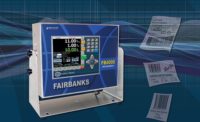Laubscher Cheese Co. was looking for a way to improve its product labeling and tracking capabilities. Currently, the firm collects data directly from its packaging lines, tracks production runs and uses production data to manage its business. To keep up with changing customer labeling and packaging demands, Laubscher wanted to upgrade its existing manual hand-written system. By introducing automation and advanced technology, Laubscher greatly increased its ability to track all production items and monitor how much is being cut daily.
Laubscher selected the Fairbanks Scales FB3000 instrument with LabelBank/DataBank Rapid Bar Code Labelling System, along with an industrial barcode printer and a set of labels, which consist of a unit label, pallet label and summary label. The user-friendly system, manufactured by Fairbanks Scales, Inc., Kansas City, Mo., was easily programmed to their specific needs and converted daily production totals from a time-consuming manual process to one that requires a simple click of a button on the computer, while offering sufficient information for all production needs.
Success based on short lead times and customer service
Laubscher Cheese Co. is a family-owned cutting, shredding and packaging company that has been in business for more than 50 years. The USDA-approved cheese grading house focuses on foodservice customers, and wholesales more than 20 million pounds of cheese a year, including all kinds of domestic and imported varieties. Based in Mercer, Pa., Laubscher Cheese serves 23 states, with main markets in New York City, New Jersey, Baltimore, Boston and Philadelphia. And, Laubscher uses its own trucks and trailers to deliver cheese, “slicing” a niche for itself by working on short lead times and offering a high level of customer service.
The short lead times are essential for many foodservice customers who do not want to tie up their money in inventory, says Kevin Watts, Laubscher’s vice president. One week a customer might buy a half a trailer load, while the next they might buy one pallet, based on business, weather, gasoline prices and the like. The foodservice companies are not the end user; if they run short on an item offered by a company that requires a 10-day lead time, they can call Laubscher Cheese, and have their product in two days shipped directly to them via Laubscher trucks.
“Our foodservice customers rely on Laubscher to service them in a very short amount of time,” says Watts. “Some of our customers will place an order on Monday and receive a Tuesday delivery in New York City, which is a 7-hour drive. That type of service, along with our quality, is the reason we have the level of business we have achieved.”
Another factor contributing to their niche position is that cheese pricing is somewhat volatile. With a short lead time, customers can play the prices a little better than if they place an order and have to guess the price of products to be delivered in 10 days.
Laubscher packages up to 20 different cheese items and pack sizes each day. To keep up with that production level and meet such short lead times, Laubscher sought to innovate its cutting and packaging process and improve record keeping and production information.
In the past, all their product lists and production reports were handwritten. The old and outdated system simply could not keep up with its need to run numerous different products every day. The process was time consuming and labor intensive, and reports were often misplaced between the production floor and the front office.
The company offers different options to meet customer demand, for example, a 3-pound cheddar rather than a 10-pound cheddar, so it needed to be able to easily make new labels. The firm also does private labels for firms that request their own company label. With their old system, Laubscher had to buy labels from a label company and affix it onto a previously labeled item, leaving them with two labels.
“We could not print different barcode formats that our customers requested, and with the age of our existing scale system, we were worried about lost production time due to equipment failure,” says Watts. “Additionally, we needed a system that is flexible enough to change with our customer’s changing demands.”
The search for a new system
Laubscher approached Fairbanks Scales’ Pittsburgh, Pa., service shop for help in selecting a new system that would meet its needs and fit the budget. They had a longstanding relationship with Fairbanks, from whom they had purchased bench scales and platform scales in the past.
Fairbanks Scales introduced Laubscher to the LabelBank system, which proved it was time to upgrade to a more productive system.
LabelBank/DataBank is designed as a complete comprehensive system that combines the scale, labeling software and data collection and reporting in one easy-to-use package. The driving force behind the system design is improving processes and solving business issues by saving on costs, reducing labor and positioning Laubscher for better value.
The system is designed to give Laubscher the ability to select different item numbers and have that item information print on labels that comply with government, traceability and other labeling standards. LabelBank adds flexibility because it allows users to add critical information to the label. The system also provides data for customers, as well data to keep track of processes. For example, Laubscher wanted to be able to go back and review information pertaining to a specific customer or pallet, pull that information up and print it out in a report that could be passed on to their customer to document that all order requirements were met.
Users can also take advantage of the FB3000 instrument to act as an interface to other applications. Using function buttons on the instrument, users can interface with other third-party software, for example, a time and attendance system. The FB3000 can be used for several functions replacing the need to purchase different instruments for industrial interface on the production floor.
The complete system includes the LabelBank/DataBank Rapid Bar Code Labeling System, an FB3000 touch screen instrument and the EasyCoder PM4i industrial barcode printer. The LabelBank software was developed in partnership with Milwaukee, Wis.-based NiceLabel, a developer of barcode and RFID labeling solutions for small and medium-sized enterprises. Laubscher selected labels that include the standard GS1-128 and UPC-A formats.
Installation begins with defining process
Before installing the system, Fairbanks worked with Laubscher to define their process and complete a product identification evaluation to organize the products, giving a unique ID to each product variation for traceability.
Fairbanks then installed the scale and calibrated it, assisted with the configuration of the label templates and how they interface with the product and configured how the instrument on the floor uses the network to communicate back to the data collection software.
Fairbanks installed the system in a networked configuration in which the FB3000 instrument with LabelBank software was installed on the production floor and the DataBank server software was installed in the front office. This allows Laubscher to see the data from the production floor as soon as a box is labeled, providing immediate information of what is being produced in the packaging process.
“We were overwhelmed with the options available, and Fairbanks worked closely with us to show how we could work with the scale,”says Deana Westlake, production manager for Laubscher. “On-site technicians trained our guys and integrated our platform scale with the new computer scale system, so they work together nicely. With Databank software in the office, we can quickly collect data-and-track production runs by customer and run reports that summarize the operation for our management team.”
Another aspect of the system is that Laubscher can process boxes faster with the scale. Given their need for speed, this feature was extremely important.
Because the FB3000 is an industrialized computer with a built-in scale, Fairbanks can offer remote support. If there are any issues, a Fairbanks technician can remote into their system and help if they have questions or need additional training. If there’s a request for label change, instead of going back and forth using email, they can get on remotely and apply the label format to the system. The remote support allows Fairbanks to respond quickly to issues, while keeping Laubscher’s costs down.
“Fairbanks Scales has helped us lower operating costs, improve our response times to customers and improve communication between the production floor and the front office,” says Watts.
With the data entry program, Laubscher Cheese can add new product codes to the Fairbanks Scale any time the need arises. This proves beneficial when an odd pack size or one-time item is wanted as soon as possible. Weight sheets, which are shipped with the bill of ladings and invoices, can be printed at a moment’s notice, which helps get drivers on the road quickly. The system also complies with customer requests to change UPC codes.
Furthermore, recall information is easy to obtain, so Laubscher can easily track such necessary details as item, quantity, weight, pack date, pack size, pallet number and customer.
“Recently, we had a request from one of our customers to make changes to the labeling of our products, so that it would meet the requirements for their system,” says Westlake. “With the LabelBank software, we are able to apply a unique label to each product, giving us the flexibility to meet these types of requests. We can print labels with barcodes for boxes and pallets as well as create different barcode formats for our customer’s labels.”
The system is extremely convenient, “allowing us to jump onto a computer and quickly make any changes to the labels we need or a new label,” adds Westlake.



